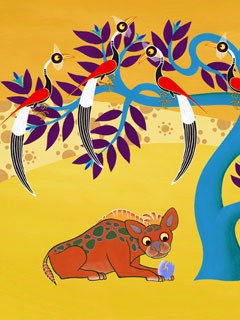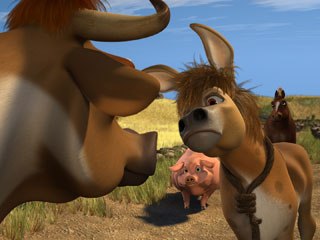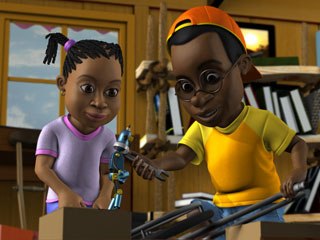South Africa and Egypt lead the way, but quality work can be found in a number of African countries, as Karen Raugust reports.

The success of animated films such as The Lion King and Madagascar suggests that properties with African themes can have significant potential with global audiences. To date, such properties have come out of Hollywood rather than Africa, but there are signs that animators on the continent may be poised to make an impact on the world market. In fact, a handful of properties produced in Africa, with African themes, are set to debut globally, including in the U.S.
Tinga Tinga Tales, for example, is a television series animated at Homeboyz Ent. in Nairobi, Kenya, produced by U.K. studio Tiger Aspect in partnership with Cbeebies, the BBC's children's channel, and Playhouse Disney. Based on Tinga Tinga art from Tanzania, the series is hand sketched and colored before being scanned to give it a traditional look. Entertainment Rights will distribute the 52 episodes starting in 2009, as well as handling licensing and merchandising.
Meanwhile, HBO acquired The Magic Cellar, a joint Canadian and South Africa production, in 2007 for HBO Family. Partners in the CG series, which consists of 20 animated folktales, include Chocolate Moose Media from Ottawa, the South African Broadcasting Corporation (SABC) and South Africa's Morula Pictures.
And the first CG feature film to come out of Africa, The Lion of Judah, was produced by Sunrise Prods. and animated by Character Matters (both South African studios) and commissioned, financed and owned by Animated Family Films in the U.S. The movie utilizes Hollywood voice talent and is expected to be released in April 2009.
The status of the animation business varies in each of the 53 countries in Africa. South Africa and Egypt have established industries, albeit small compared to other global animation centers, while some nations have virtually no industry. "It is difficult to look at the continent of Africa as a whole undifferentiated mass," explains Paula Callus, a specialist in the study and research of African animation and faculty member in animation at Bournemouth University. "Each separate country has a very different landscape of animation, varying from independent self-funded filmmakers, grant-funded initiatives through UNESCO, UNICEF or The French Ministry of Cultural Affairs, to small and large local production studios."
South Africa
South Africa has the most diverse animation output of any nation on the continent, both in terms of style and medium. Much of the work to date has been completed on a service basis, with a significant focus on commercials. However, more studios are starting to be active in the entertainment arena, including developing proprietary properties and investigating co-productions down the road.
"In the short-term, the industry needs to go through some usual challenges facing a growing industry, but in the long term I think the South African animation industry will be a serious player, not only in commercials and TV but more and more so in CGI feature films," says Phil Cunningham, executive producer at Sunrise Prods. In addition to The Lion of Judah, Sunrise also produced a stop-motion film called The Legend of Sky Kingdom, among other projects.
However, service work continues to account for the bulk of work. "As [South Africa is] Africa's economic powerhouse, with strong international relationships and an overall good perception and reputation, South African companies are therefore well placed to service international clients," says Roger Smythe, co-founder of Masters & Savant Worldwide, one of the largest studios in South Africa. He cites factors such as the country's reputation for creativity, time zone advantages, favorable exchange rates, and a strong work ethic as benefits of working with South African studios.
Masters & Savant specializes in commercial and branding work and is currently pitching four commercial projects for the Middle East, creating an identity for a Gospel channel, completing the branding and holiday commercials for Musica, a local retailer, creating an animated corporate video for the MTN cellular network, and producing two public service announcements.
Another leading studio, Triggerfish, focuses almost entirely on international clients. "Unfortunately, in South Africa, animation is often seen as the 'low-cost option,' so the domestic budgets do not allow for fluid 2D animation or high-quality 3D," says Stuart Forrest, producer. "We therefore do 90% of our work for overseas clients, particularly in the U.S. where we can take advantage of exchange rates and our relatively low cost of production."
Triggerfish launched with a focus on stop-motion commercial work, expanded into children's TV animation, and, more recently, has concentrated on CG productions, including direct-to-DVDs for U.S. and other international clients. It made its name on the global market as the lead animation provider for Takalani Sesame, the African version of Sesame Street, on which it collaborated with 10 studios across the country. It has three feature films in development, including Zambezia, which starts production this February, and Khumba, which is scheduled to go into production in June.
Some studios in South Africa produce mainly for the local market. Anamazing Workshop, for example, produces animation with African themes, mostly for South Africa. A recent project was Backyard Shorts, a collection of 13 short films produced at its in-house Animation Production Training Institute, which aired on SABC and in theaters around the country earlier this year.
While the South African animation community is large compared to other countries in Africa, it is still small from a global perspective. There are about 20 established animation and vfx studios in the country, according to estimates, mostly small (two to three people) or medium in size. A few larger studios, with staffs of 30 to 35, dominate the commercial, vfx and long-form character animation sectors, but smaller studios can be profitable by specializing in commercials or motion graphics.
While the industry is small, South African studios have developed a reputation for quality. Compared to studios in Asia, "we tend to give more attention and better quality with a competitive budget," says Ivan Greyling of Character Matters, a CG studio that has been in business for 15 years.
South Africa is the rare country in the region where there is government support available for animation. The Department of Trade and Industry offers a rebate of 15% of productions and 30% of co-productions if the local spend is more than $100,000, while the Industrial Development Corp. provides funds for films made in South Africa. Regional film commissions such as the Cape Film Commission in Cape Town also have been supportive of animation.
Animation SA is a nonprofit group representing the interests of the local industry. It has a presence at film festivals, holds monthly networking meetings that attract 150 people on average, and operates a website for networking and to promote South African animation companies. Animation SA has 1,800 members and a database of about 2,000, mostly comprised of animators with some experience.
"South Africa is breaking into the world animation market, and we're seeing more and more interest from abroad," says Forrest. "With a wealth of untapped creative artists and very high production values, it's just a matter of time before the industry explodes."
Egypt
Egypt also hosts a significant animation production business, with more than 50 animation studios, according to Mohamed Ghazala, an animator, animation historian and faculty member at Minia University in Egypt, one of the relatively few institutions in Africa that offer animation programs. His films include Carnival (2001), Crazy Works (2002) and HM HM (2005). Ghazala also is director of ASIFA Egypt, which was established in Cairo in October 2008 as the first ASIFA chapter in Africa.
The number of studios in the country has expanded throughout the 1990s and 2000s. About 10 of these account for much of the production, responsible for over 100 hours annually of television episodes, commercials and shorts. Examples of studios include Al Sahar, which has an animated feature, The Knight and Princess, in development; Tarek Rashed Studio, which got its start in commercials in the early 2000s and has since expanded into co-productions with Arab countries for local series; Zamzam, which produces Islamic series in clay animation; and A+ Cartoon, which uses Flash to produce series for Egyptian TV.
The number of animators in Egypt also is growing, with academies such as Cinema Institute, Helwan University and Minia offering animation classes and more than 200 new students graduating every year with at least two years' of training. Ghazala estimates that about half of these pursue animation as a career.
Egyptian studios services customers mainly in Egypt and nearby Middle Eastern and North African markets, including Saudi Arabia, Dubai, Qatar, Libya, Yemen and Kuwait, Ghazala says. The majority of work consists of 2D and clay animation, with some specialists offering 3D and Flash.
Other Countries
Outside of South Africa and Egypt, animation production is limited mostly to a few small studios and independent animators in countries such as Mauritius and Kenya, working primarily in 2D animation, along with some Flash and Maya work. Much of their output consists of a small number of short films and commercials, with very little long-form entertainment content. "We do a lot of work for Kenya, Nigeria, Malawi, because there are very limited animation resources available in these countries," says Forrest.
Studios tend to come and go. Some relocate to countries where the business environment is better; Character Matters, for example, began in Harare, Zimbabwe, in 1993, but was forced to move to South Africa, which had more business advantages, a decade later. Others simply go out of business. Pictoon, a studio in Dakar, Senegal, one of the poorest countries in the world, produced a children's series called Kabango le Griot, which was a hit on the Canal France International satellite service in 2003 and generated a lot of publicity. But the studio subsequently ran into financial difficulties and had to cut its staff.
There are positive signs in some regions. Homeboyz Ent., a company in Kenya that has several businesses in radio and music production, launched an animation studio to complete Tinga Tinga Tales. It employs local designers, writers, musicians and animators for the production and plans to continue creating African animation for global distribution after work on this production ends. A couple of other small studios are working on animation seriously in this country as well, according to CEO Myke Rabar and Angelina Koinange of Homeboyz.
Even countries without an animation industry per se have some independent artists at work, reports Callus, citing Jean Michel Kibushi in the Democratic Republic of Congo and Moustapha Alassane in Niger. In Ethiopia, a country with virtually no animation industry, a UNICEF-funded studio called Whizkids produced Tsehai Loves Learning, an educational puppet and animation series in the Ethiopian language of Amharic that garnered international awards.

One initiative that helped further the animation industry in Kenya and throughout Africa in recent years was UNESCO's Africa Animated!, based in Nairobi. Its intent was to train local animators and encourage the production of animation with African themes. The initiative offered three training workshops in Kenya, Tanzania and South Africa, which were attended by animators from 10 countries and yielded 20 short films, some of which went on to win awards in global festivals.
Partners included the United Nations Development Programme, South African Broadcasting Corporation, the Mauritian government, Canal France International, the French Embassy in Nairobi, Bournemouth University, Parsons School of Design, Kenya College of Communications, regional broadcasters, educational and professional institutions in Africa and others. The plan was ultimately to set up a permanent training facility, but the initiative has gone dormant since its founder, Alonso Aznar, relocated out of Africa.
Future Promise
Challenges facing animators in Africa vary depending on the country. In many nations, barriers include a lack of training facilities and institutions that offer animation courses, along with a subsequent lack of production-ready talent; a dearth of investment in local series and commercials; and an economic situation that makes it difficult and expensive to buy equipment and software. Meanwhile, local animation houses face competition from international studios, since networks and other distribution channels rely mostly on foreign fare, particularly for children, and animators in most countries have very little or no government support. In addition, many talented animators end up leaving the region for greener pastures in Europe or the U.S.
Animators in Africa also have to deal with a lack of recognition from the international community. "[There is] a perception internationally about South Africa and Africa as a whole, that it is a third world country and continent, not able to produce anything of interest," Greyling says.
"We've got the talent, we can do the work -- we just need the rest of the world to switch onto that fact," agrees Forrest.
Animators in Africa also are striving to develop a definitive style, which is difficult since many have been trained by European or American animators. "The biggest challenge -- and the one I undertook with Africa Animated! -- is to have a production made by Africans, for Africans and with images, scripts and music from that continent," says Aznar. He worries that the disappearance of Africa Animated! will prevent the industry from developing further in sub-Saharan Africa. "This is particularly sad since there is a treasure trove of talents ready to produce high-quality animation," he says.
Observers agree that there is no lack of creative artists capable of producing quality work. "The most positive sign is that there is a group of creative hands that come from Kenya, Ghana, Morocco, Algeria and Zimbabwe, in addition to Egyptian and South African artists," Ghazala says. "In fact, I'm optimistic!"
"Many young people are taking an interest in animation and realizing that it could be a viable career path for them," adds Greyling.
Koinange and Rabar point out that big international animation companies are coming in to train people in countries like Kenya, and that both the quality and quantity of work are on the rise.
"Not withstanding economic, social or political strife, the type of work that is being produced is qualitatively comparable to any animation being made in the West," says Callus. "The talent is not lacking; it is the support to enable this talent to grow and blossom that needs to be worked on."
Karen Raugust is a Minneapolis-based freelance business writer specializing in animation, publishing, licensing and art. She is the author of The Licensing Business Handbook (EPM Communications).












